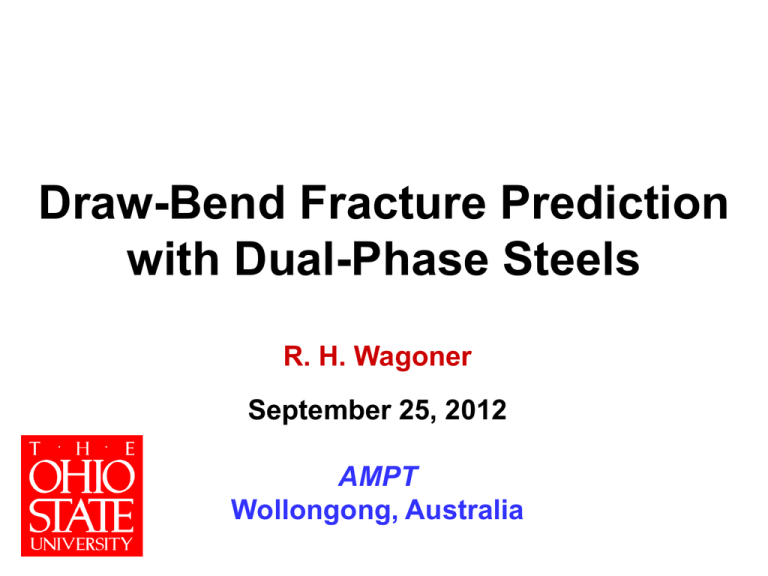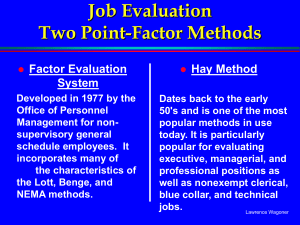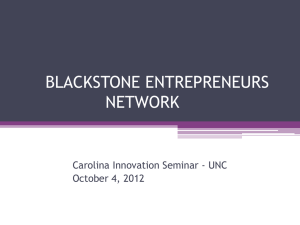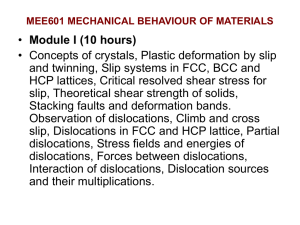
Draw-Bend Fracture Prediction
with Dual-Phase Steels
R. H. Wagoner
September 25, 2012
AMPT
Wollongong, Australia
Outline
1. Background – Shear Fracture, 2006
2. DBF Results & Simulations, 2011
Intermediate Conclusions
3. Practical Application, 2012
Ideal DBF Test
Recommended Procedure
4. No Ideal Test?
Results,
Recommended Procedure
R. H. Wagoner
2
1. Background – Shear Fracture, 2006
R. H. Wagoner
3
Shear Fracture of AHSS – 2005 Case
Jim Fekete et al, AHSS Workshop, 2006
R. H. Wagoner
4
Shear Fracture of AHSS - 2011
Forming Technology Forum 2012 Web site: http://www.ivp.ethz.ch/ftf12
R. H. Wagoner
5
Unpredicted by FEA / FLD
Stoughton, AHSS Workshop, 2006
R. H. Wagoner
6
Shear Fracture: Related to Microstructure?
Ref: AISI AHSS Guidelines
R. H. Wagoner
7
Conventional Wisdom, 2006
Shear fracture…
•
•
•
•
is unique to AHSS (maybe only DP steels)
occurs without necking (brittle)
is related to coarse, brittle microstructure
is time/rate independent
Notes:
• All of these based on the A/SP stamping trials, 2005.
• All of these are wrong.
• Most talks assume that these are true, even today.
R. H. Wagoner
8
NSF Workshop on AHSS (October 2006)
Elongation (%)
70
60
50
40
Mild
30
BH
20
10
0
MART
0
300
600
900
Tensile Strength (MPa)
1200
1600
R. W. Heimbuch: An Overview of the Auto/Steel Partnership and Research Needs [1]
R. H. Wagoner
9
2. DBF Results & Simulations, 2011
R. H. Wagoner
10
References: DBF Results & Simulations
J. H. Kim, J. H. Sung, K. Piao, R. H. Wagoner: The Shear Fracture of
Dual-Phase Steel, Int. J. Plasticity, 2011, vol. 27, pp. 1658-1676.
J. H. Sung, J. H. Kim, R. H. Wagoner: A Plastic Constitutive Equation
Incorporating Strain, Strain-Rate, and Temperature, Int. J.
Plasticity, 2010, vol. 26, pp. 1746-1771.
J. H. Sung, J. H. Kim, R. H. Wagoner: The Draw-Bend Fracture Test (DBF)
and Its Application to DP and TRIP Steels, Trans. ASME: J. Eng.
Mater. Technol., (in press)
R. H. Wagoner
11
DBF Failure Types
V2
Type III
Type II
65o
Type I
65o
V1
Type I: Tensile failure (unbent region)
Type II: Shear failure (not Type I or III)
Type III: Shear failure (fracture at the roller)
R. H. Wagoner
12
DBF Test: Effect of R/t
R. H. Wagoner
13
“H/V” Constitutive Eq.: Large-Strain Verification
1000
DP590(B), RD
Hollomon <>=4MPa
-3
Effective Stress (MPa)
Strain Rate=10 /sec
900
o
25 C
H/V <>=1MPa
800
Bulge Test (r=0.84, m=1.83)
Voce <>=1MPa
700
Tensile Test
Fit
Range
600
0.1
Extrapolated, Bulge Test Range
0.2
0.3
0.4
0.5
0.6
0.7
Effective Strain
R. H. Wagoner
14
FE Simulated Tensile Test: H/V vs. H, V
Engineering Stress (MPa)
700
Experiment(D-B)
600
Voce H/V model Hollomon
500
DP590(B), RD
400
-3
Strain Rate=10 /s
o
100 C, Isothermal
300
0
0.05
0.1
0.15
0.2
0.25
0.3
Engineering Strain
R. H. Wagoner
15
Predicted ef, H/V vs. H, V: 3 alloys, 3 temperatures
Standard deviation of ef: simulation vs. experiment
Hollomon
Voce
H/V
DP590
0.05 (23%)
0.05 (20%)
0.02 (7%)
DP780
0.03 (18%)
0.04 (22%)
0.01 (6%)
DP980
0.04 (30%)
0.03 (21%)
0.01 (5%)
R. H. Wagoner
16
FE Draw-Bend Model: Thermo-Mechanical (T-M)
U2, V2
hmetal,air = 20W/m2K
•
•
•
•
Abaqus Standard (V6.7)
3D solid elements (C3D8RT), 5 layers
Von Mises, isotropic hardening
Symmetric model
m = 0.04
hmetal,metal = 5kW/m2K
U1, V1
R. H. Wagoner
Kim et al., IDDRG, 2009
17
Front Stress vs. Front Displacement
1000
Measured
Front Stress, 1
800
T-M
Isothermal
Solid, Shell
600
400
DP780-1.4mm, RD
V1=51mm/s, V2/V1=0
200
R/t=4.5
0
0
20
40
60
80
Front Displacement, U (mm)
1
R. H. Wagoner
18
Displacement to Maximum Front Load vs. R / t
80
UMax. Load (mm)
Isothermal, Shell
Isothermal, Solid
60
Type I
40
T-M, Solid
Type III
20
Measured
DP780-1.4mm, RD
V =51mm/s, V /V =0
2
1
1
0
0
2
4
6
8
10
12
14
R/t
R. H. Wagoner
19
Is shear fracture of AHSS
brittle or ductile?
R. H. Wagoner
20
Fracture Strains: DP 780 (Typical)
R. H. Wagoner
21
Fracture Strains: TWIP 980 (Exceptional)
R. H. Wagoner
22
Directional DBF : DP 780 (Typical)
R. H. Wagoner
23
Directional DBF Formability: DP980 (Exceptional)
Elongation to Fracture (mm)
30
25
20
15
10
5
0
0
RD
R. H. Wagoner
DP980
R/t = 3.3
30
60
Angle to RD (degree)
90
TD
24
Interim Conclusions
• “Shear fracture” occurs by plastic localization.
• Deformation-induced heating dominates the error
in predicting shear failures.
• Brittle cracking can occur. (Poor microstructure or
exceptional tensile ductility, e.g. TWIP).
• T-dependent constitutive equation is essential.
• Shear fracture is predictable plastically.
(Challenges: solid elements, T-M model.)
R. H. Wagoner
25
3. Practical Application - 2012
R. H. Wagoner
26
DBF/FE vs. Industrial Practice/FE
Ind.: Plane strain
High rate
~Adiabatic
FE: Shell
Isothermal
Static
DBF: General strain
Moderate rates
Thermo-mech.
FE: Solid element
Thermo-mech.
R. H. Wagoner
27
Ideal DBF Test: Plane Strain, High Rate
R. H. Wagoner
28
Ideal Test Results - Stress
Peak Engineering Stress (MPa)
1200
1000
Analytical PS Result
800
(UTS)
600
(R/t)*
400
DP780-1.4mm
0
R. H. Wagoner
2
4
6
8
10 12
Bending Ratio, R / t
14
29
Ideal Test Results - Strain
0.4
Analytical PS Results
DP 780 - 1.4mm
(R/t)*
True Strain
0.3
0.2
Outer Strains
0.1
Center Strains
(Membrane)
FLDo
Inner Strains
0
0
R. H. Wagoner
2
4
6
8
10
Bending Ratio, R / t
12
14
16
30
How to Use Practically: Bend, Unbend Regions
R. H. Wagoner
31
Practical Application of SF FLD – (1) Direct
For each element in contact
Known: R, t e*membrane
Predicted Fracture: eFEA > e*membrane
R. H. Wagoner
32
Practical Application of SF FLD – (2) Indirect
For each element drawn over contact
Known: (R, t)contact Pmax *PS tension e*PS tension
Predicted Fracture: eFEA > e*PS tension
Wu, Zhou, Zhang, Zhou, Du, Shi: SAE 2006-01-0349.
R. H. Wagoner
33
Calculation: Indirect Method
R. H. Wagoner
34
Recommended Procedure with Industrial FEA
1. Use adiabatic law in FEA, use rate sensitivity
2. Classify each element based on X-Y position (tooling)
a) Bend (plane-strain)
b) After bend (plane-strain)
c) General (not Bend, not After)
3. Apply 4 criteria:
a) FLD (Bend, After)
b) Direct SF (Bend)
c) Indirect SF (After)
d) Brittle Fracture* (All?)
R. H. Wagoner
35
4. No Ideal Test?
(What to do?)
R. H. Wagoner
36
Pmax = f(R/t)
e*membrane = f(R/t)
(PS, high-speed DBF)
(PS, high-speed DBF)
1200
0.4
1000
0.3
Membrane Strain
Peak Load (MPa)
What is Needed?
800
600
0.2
0.1
400
0
0
2
4
6
8
10
Bending Ratio, R / t
R. H. Wagoner
12
14
0
2
4
6
8
10
Bending Ratio, R / t
12
14
16
37
FE Plane Strain DBF Model
m = 0.06
U2, V2 = 0
•
•
•
•
Abaqus Standard (V6.7)
Plane strain solid elements (CPE4R), 5 layers
Von Mises, isotropic hardening
Isothermal, Adiabatic, Thermo-Mechanical
U1, V1
R. H. Wagoner
38
Adiabatic Constitutive Equation
1600
True Stress (MPa)
-5%
25oC
-12%
75oC
1200
125oC
Adiabatic
800
adiabatic (e , e ) (e , e , T )
e
T
de
C p 0
DP980(D)-GA-1.45mm
400
-3
de/dt=10 /s
0
0
0.2
0.4
0.6
0.8
1
True Plastic Strain
R. H. Wagoner
39
Peak Stress, Plane-Strain: DP980
Peak Engineering Stress (MPa)
1400
Analytical Model,
Plane Strain
PS FE Model,
m=0, m=0
1200
UTS
1000
DBF measured
(RD, TD)
800
600
DP980-1.43mm
0
2
4
6
8
10
12
14
R/t
R. H. Wagoner
40
Membrane Strains at Maximum Load
0.25
Analytical Adiabatic Model
Stopped at Maximum Load
es, True Membrane Strain
DP590
0.2
0.15
DP780
0.1
DP980
0.05
0
0
2
4
6
8
10
12
14
16
Bending Ratio, R / t
R. H. Wagoner
41
Analytical Model: Model vs. Fit
0.1
es, True Membrane Strain
Analytical Adiabatic Model
Stopped at Maximum Load
DP980
0.08
S = 0.221, e = 0.088
s
o
t t
t
t
S
es eso
R
R
R
R
max
max
0.06
DP780
0.04
S = 0.198, e
s
o
= 0.101
DP590
0.02
S = 0.167, e
s
o
= 0.138
0
0
0.1
0.2
0.3
0.4
0.5
0.6
1 / Bending Ratio, t / R
R. H. Wagoner
42
Analytical Model: Model vs. Fit
es, True Membrane Strain
0.25
Analytical Adiabatic Model
Stopped at Maximum Load
0.2
DP590:
S = 0.168, e
o
s
0.15
DP780: S = 0.198, e
s
o
= 0.138
= 0.101
0.1
DP980:
0.05
0
t t
t
t
S
es eso
R
R
R
R
max
max
0
2
4
6
8
S = 0.221, e
s
10
12
o
= 0.088
14
16
Bending Ratio, R / t
R. H. Wagoner
43
Conclusions
• Shear fracture is predictable with careful testing or careful
constitutive modeling and FEA.
• “Shear fracture” occurs by plastic localization.
• “Shear fracture” is an inevitable consequence of draw-bending
mechanics. All materials.
• Brittle fracture can occur, but is unusual. (Poor microstructure or
v. high tensile tensile limit, e.g. TWIP).
• T-dependent constitutive equation is essential for AHSS because
of high plastic work. (But probably not Al or many other alloys.)
R. H. Wagoner
44
Thank you.
R. H. Wagoner
45
References
•
R. H. Wagoner, J. H. Kim, J. H. Sung: Formability of Advanced High Strength Steels,
Proc. Esaform 2009, U. Twente, Netherlands, 2009 (CD)
•
J. H. Sung, J. H. Kim, R. H. Wagoner: A Plastic Constitutive Equation Incorporating
Strain, Strain-Rate, and Temperature, Int. J. Plasticity, (accepted).
•
A.W. Hudgins, D.K. Matlock, J.G. Speer, and C.J. Van Tyne, "Predicting Instability at Die
Radii in Advanced High Strength Steels," Journal of Materials Processing
Technology, vol. 210, 2010, pp. 741-750.
•
J. H. Kim, J. Sung, R. H. Wagoner: Thermo-Mechanical Modeling of Draw-Bend
Formability Tests, Proc. IDDRG: Mat. Prop. Data for More Effective Num. Anal., eds. B. S.
Levy, D. K. Matlock, C. J. Van Tyne, Colo. School Mines, 2009, pp. 503-512. (ISDN 978-0615-29641-8)
•
R. H. Wagoner and M. Li: Simulation of Springback: Through-Thickness Integration, Int. J.
Plasticity, 2007, Vol. 23, Issue 3, pp. 345-360.
•
M. R. Tharrett, T. B. Stoughton: Stretch-bend forming limits of 1008 AK steel, SAE
technical paper No.2003-01-1157, 2003.
•
M. Yoshida, F. Yoshida, H. Konishi, K. Fukumoto: Fracture Limits of Sheet Metals Under
Stretch Bending, Int. J. Mech. Sci., 2005, 47, pp. 1885-1896.
R. H. Wagoner
46
Extra Slides
R. H. Wagoner
47
DP Steels
1200
Engineering Stress(MPa)
DP980(D)-1.45mm
1000
800
DP780(D)-1.4mm
600
DP590(B)-1.4mm
400
Strain Rate: 10-3/sec
Room Temp.
Rolling Direction
200
0
0
5
10
15
20
25
Engineering Strain (%)
R. H. Wagoner
48
“H/V” Constitutive Framework
(e , e , T ) f (e , T ) g (e ) h(T )
Special:
f (e , T ) (T ) f Hollo (1 (T )) fVoce
(T ) 1 2 (T TRT )
f Hollo
Ke n
fVoce A[1 B exp(Ce )]
Standard:
e
g (e )
e
a [log e ] b
0
h(T ) (1 D (T TRT ))
R. H. Wagoner
Sung et al., Int. J. Plast. 2010
49
Simulated D-B Test: Effect of Draw Speed
1.2
Isothermal
1
F/F
UTS
0.8
Adiabatic
0.6
13mm/s
(0.6/s)
51mm/s
(de/dt=2.5/s)
0.4
-3
(5x10 /s)
2.5mm/s
(0.13/s)
DP980(D)
R/t=4.4, V2/V1=0
0.2
0
0.001mm/s
0
5
10
15
20
25
30
35
Front Displacement (mm)
R. H. Wagoner
50
DBF Formability: DP980(A), RD vs. TD (Typical)
* Directional Formability: TD=RD
DP980(A)
V =51mm/sec
40
1
V /V =0
2
f
Front Disp. to Failure (U , mm)
50
1
30
20
RD
TD
10
0
2.2
3.4
4.5
5.5
6.6
7.8
10
13.3
R/t
R. H. Wagoner
51
DBF Formability: DP980(D), RD vs. TD (Exceptional)
* Directional Formability: RD>TD
50
f
Front Disp. to Failure (U , mm)
60
DP980(D)
V1=51mm/sec
V2/V1=0
40
30
20
RD
10
TD
0
2.2
3.3
4.4
5.4
6.6
7.7
9.9
13.1
R/t
R. H. Wagoner
52
Analytical Model – Curvilinear Derivation
r
r
e ln
e
2
3
n
ee
ij
ij
(r )
Neutral line
3
t
r
r
ln
2
2
dr (r )
r
3
3
rn
R t
2
2
2
(r ) dr dr (r )
rn
r
3
3
3
R t
r
2
n
r rn
r rn
Materially embedded coordinate :
dr r d
R
T
rn
R t0
T
rn
d
r
2
2 r
d ( )
3
3
( )
n
n
2
2 r
2 r
( ) d d ( )
n
3
3
3
n
R t0
T
R t
R t0
R
R
dr
r
d
Fracture Criterion: Fracture occurs at Tmax for given R, to
R. H. Wagoner
53
DBF Interpretation: Plane-strain vs. Tension
Peak Engineering Stress (MPa)
1200
Simplified FE Model,
m=0, m=0
1000
UTS
800
600
Analytical Model,
Plane Strain
400
DP780-1.4mm
0
2
4
6
8
10
12
14
R/t
R. H. Wagoner
54
Inner and Outer Strains at Maximum Load
0.4
DP590
Analytical Adiabatic Model
Stopped at Maximum Load
DP780
True Strain
0.3
DP980
Outer Strains
0.2
0.1
Inner Strains
0
0
2
4
6
8
10
12
14
16
Bending Ratio, R / t
R. H. Wagoner
55
Membrane Strains (R/t Affected Only)
0.25
es, True Membrane Strain
Analytical Adiabatic Model
Stopped at Maximum Load
0.2
0.15
DP980
DP780
0.1
0.05
DP590
0
0
2
4
6
8
10
12
14
16
Bending Ratio, R / t
R. H. Wagoner
56
R/t-Affected Membrane Strains vs. t/R
0.25
es, True Membrane Strain
Analytical Adiabatic Model
Stopped at Maximum Load
0.2
0.15
DP980
DP780
0.1
0.05
DP590
0
0
0.1
0.2
0.3
0.4
0.5
0.6
1 / Bending Ratio, t / R
R. H. Wagoner
57
Forming Limit Diagram
Ref: Hosford & Duncan
R. H. Wagoner
58
PS T-M Model: Model vs. Fit
es, True Membrane Strain
0.25
Plane Strain Thermo-Mechanical Model
Stopped at Maximum Load
DP590
0.2
t t
t
t
S
es eso
R
R
R
R
max
max
S = 0.753, e
o
s
= 0.149
0.15
DP780
S = 0.330, e
0.1
o
= 0.123
o
= 0.133
s
0.05
DP980
0
S = 0.051, e
s
-0.05
0
0.1
0.2
0.3
0.4
1 / Bending Ratio, t / R
R. H. Wagoner
59
PS T-M Model: Model vs. Fit
es, True Membrane Strain
0.5
Plane Strain Thermo-Mechanical Model
Stopped at Maximum Load
t t
t
t
S
es eso
R
R
R
R
max
max
0.4
DP590
S = 0.753, e
0.3
o
s
= 0.149
0.2
0.1
DP780: S = 0.330, e
o
= 0.123
DP980: S = 0.051, e
o
= 0.133
s
s
0
0
2
4
6
8
10
12
14
16
Bending Ratio, R / t
R. H. Wagoner
60
Draw-Bend Fracture Test (DBF): V1, V2 Constant
190.5 mm
Tool radius choices:
2/16, 3/16, 4/16, 5/16, 6/16, 7/16, 9/16, 12/16 inch
3.2, 4.8, 6.4, 7.9, 9.5, 11.1, 14.3, 19 mm
= V2/V1:
0 and 0.3
444.5 mm(10”)
Specimen width: 25mm
R
190.5 mm
Max. Finish
Start
V2 = V1
444.5 mm (10”)
uf V1
Max. Finish
Start
Wagoner et al., Esaform, 2009
R. H. Wagoner
61
AHSS vs. HSLA
Ref: AISI AHSS Guidelines
R. H. Wagoner
62







